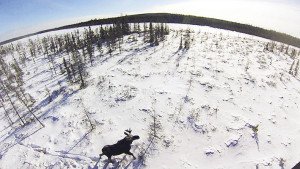St. Paul—Minnesota’s moose population remains low despite a slowing population decline during the past five years, according to the Minnesota DNR.
Results from the 2016 aerial moose survey indicate that the population change from an estimated 3,450 in 2015 to 4,020 in 2016 is not statistically significant. Northeastern Minnesota’s current moose population could be as high as 5,180 or as low as 3,230.
“Moose are not recovering in northeastern Minnesota,” said Glenn DelGiudice, moose project leader for the DNR. “It’s encouraging to see that the decline in the population since 2012 has not been as steep, but longer term projections continue to indicate that our moose population decline will continue.”
Annual population comparisons are made to 2006 because northeastern Minnesota’s highest moose population estimate of 8,840 occurred that year. Since then, the moose population has declined 55 percent.

continue to decline. | MN DNR
Studies have shown that adult moose survival has the greatest long-term impact on moose populations. Northeastern Minnesota’s collective moose population may be reflecting the annual survival rate of moose collared as part of the DNR’s moose mortality research project, which shows that survival of adult moose increased from 81 percent in 2013 to 88 percent in 2014 and 85 percent in 2015.
DelGiudice said more calves surviving beyond their first year also may be slowing the short-term population decline. Data collected in fall and early winter 2015 document the number of calves that remained with their mothers. These data reflect the 2016 population survey estimate that 17 percent of Minnesota moose are calves, up from 13 percent in 2015 and 15 percent in 2014.
This year’s survey involved flying 52 survey plots distributed across northeastern Minnesota from Jan. 4-15. The Fond du Lac Band of Lake Superior Chippewa and 1854 Treaty Authority contributed funding and provided personnel to assist Minnesota DNR with the annual moose survey.
A copy of the aerial survey report and more information about Minnesota moose are available on the DNR website at www.mndnr.gov/moose.






